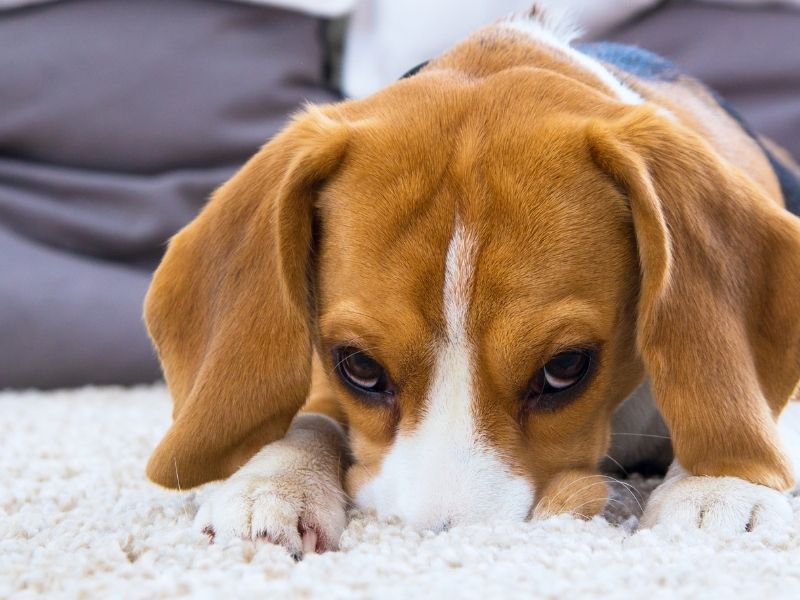
How to Stop a Dog from Marking in the House for Good
This post may include affiliate links. Please read my disclosure policy.
Urine marking is a common behavior, particularly in male dogs. Dogs mark with their urine to assert ownership of objects and areas, leaving a scent message for other dogs. Female dogs mark with their urine too, especially during their heat cycle. This natural behavior is a way for dogs to communicate and establish social hierarchy.
What’s the Difference Between Peeing and Marking?
Your dog may pee inside if they haven’t been let out enough, if they have a small bladder, or for many other reasons. But the peeing will result in a full puddle of urine.
Whereas, in marking, you’ll only find a small amount of urine, and it’s often found on the same spot or object.
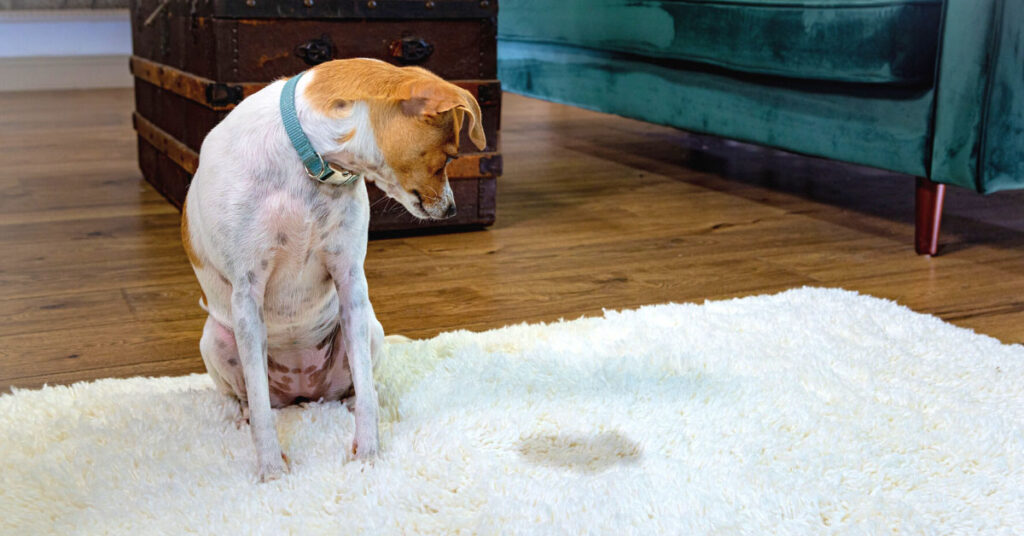
It’s considered natural behavior when dogs mark a certain spot, but it’s certainly not acceptable in the house. Furniture, floors, walls, and other items are ruined or damaged when your dog decides to claim them as his own.
Urine marking is not the result of faulty housebreaking. In fact, most of the time, urine marking can be curbed with behavior modification.
Why Is Your Dog Marking in Your House?
One of the most common reasons dogs start urine marking inside your home is the addition of anything or anyone new, be it a new dog or cat, a baby, a new partner, or even new furniture. This behavior can be particularly prevalent in multi-dog households where there’s competition for resources, attention, or status. By territory marking, a dog is basically saying, “This is my space. Keep out.”
Other triggers may be stress, like moving to a new home or even a change in your and your pup’s routine. Certain forms of anxiety, like separation anxiety, can also cause this behavior. Dogs urine mark as a coping mechanism, providing them with a sense of security and familiarity in response to perceived threats or changes.
If your dog urinates more frequently in your home, this may also indicate underlying health issues. Certain diseases may result in increased urination, which can be misconstrued as marking behavior.
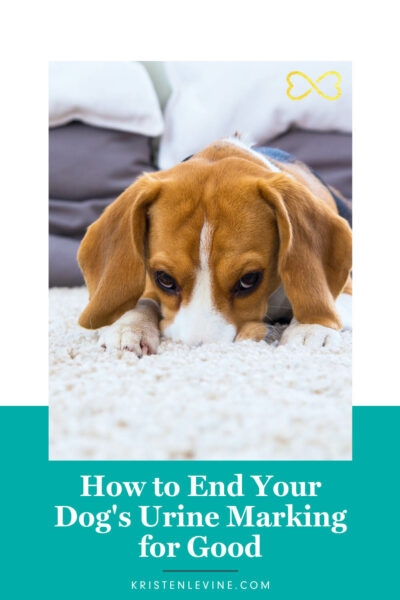
How to Stop Dog Marking in the House
Spay or Neuter Your Dog
For both female dogs and male dogs, spaying or neutering will reduce or stop marking behavior. According to the North American Veterinary Community, as many as 50% of male dogs stop scent marking, or at least do it significantly less often, after being neutered.
Intact male dogs usually begin marking when they start to reach sexual maturity.
If you have a puppy, neutering him as soon as he’s old enough is one of the best ways to stop indoor marking from starting in the first place.
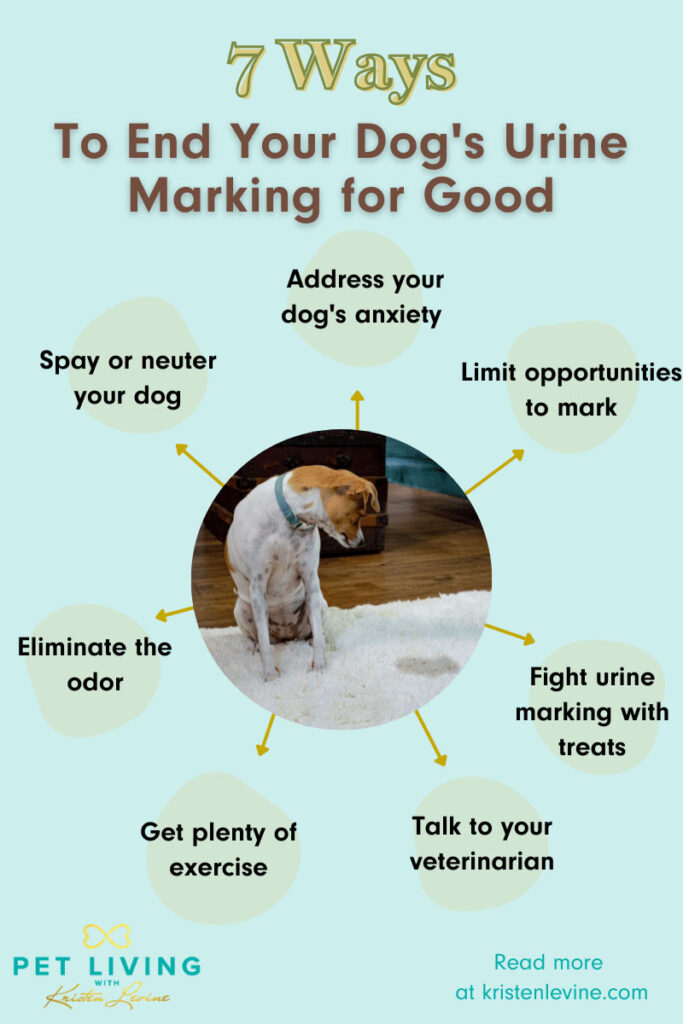
However, it may be days or even weeks for the urine marking behavior to stop after your dog is altered since hormones gradually decline rather than come to a screeching halt.
And it will likely also take some additional house training on your part to change the marking behavior if it has become a deeply ingrained habit.
If your male dog is peeing in the house weeks or months after he’s altered and after you’ve taken the steps below, there could be other behavioral or physical issues that need to be addressed.
Address Your Dog’s Anxiety
If your dog’s marking is caused by something like separation anxiety, you’ll want to address it sooner than later, especially since anxiety can escalate as your dog ages.
This is one reason why it’s important not to yell at your dog when he marks. If he’s doing it out of anxiety, yelling may make it much worse.
Some dogs experience noise anxiety, social anxiety, or separation anxiety. These fears can make a dog react with unwanted behaviors, like urine marking.
There are several OTC (over-the-counter) anxiety tools that can help alleviate your pup’s anxiety. I love this pheromone collar from Adaptil.
My dog, Chilly, had severe anxieties, especially around loud noises, and this collar was a very effective tool we used to manage it. The pheromones have a calming effect on some dogs and can reduce the urge to mark. There is also a room diffuser if you prefer that.
There are also many food-based remedies for calming anxiety, including calming probiotics and calming foods.
Ultimately, if your dog has anxiety, you may need to enlist the help of a veterinary behaviorist to work through it. You can find a behaviorist in your area using this page on the dacvb.org site.
You can also check out my pet anxiety resource page for more information about anxiety signs and solutions.
Eliminate the Odor
As long as the odor from your dog’s urine is still there, he’ll likely continue to mark the same spot. So it’s important to clean it up correctly, with a bio-enzymatic cleaner designed to eliminate biological waste, like urine. Be sure to let these completely dry to eliminate all traces of organic matter.
An enzyme cleaner works by eating the bacteria that’s causing odor and stains. Ordinary household cleaners will do little to eliminate the mess. If you’re in doubt, take a black light to any mess you’ve cleaned without using a bio-enzymatic cleaner, and you’ll be convinced!
Kinderbean No-Stress Mess Eraser is, paws-down, the best cleaner for pet mess, in my opinion. I’ve tested a lot of cleaners, and most have come up short in one way or another.
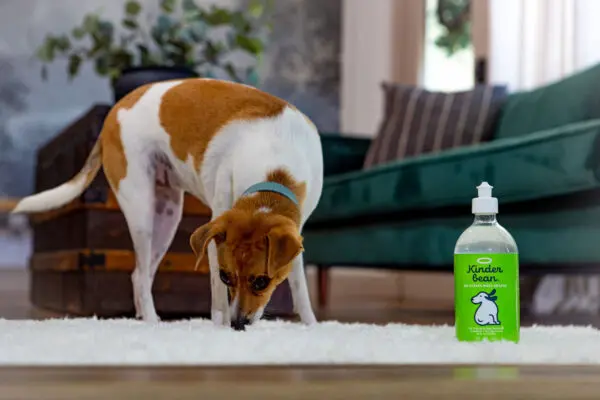
Whichever cleaner you choose, make sure it is:
- Bio-enzymatic
- Safe for pets (both in chemical composition and odor)
- Doesn’t contain harsh dyes that could discolor surfaces
- Contains natural ingredients
- Has a durable dispenser (many have cheap spray tops that break in shipping)
Once you have your cleaner, you need to use it properly to make sure it eliminates the odor.
- Soak up as much urine as possible with a paper towel.
- Saturate the spot with the cleaner. This is important so it can make contact with the urine and eat the bacteria.
- If the spot is horizontal, lay a clean cloth over the top and allow it to set overnight or 12–24 hours. If the spot is vertical, allow the cleaner to air dry.
- Retreat if necessary.
It’s a very simple process, but it’s so important not to simply “spray and wipe away.”
- Enzyme-Powered Cleaner: Simple ingredients, powered by plants. Powerful, bio-enzymatic formula biodegrades odor and stain molecules leaving nothing behind.
- Any Stain, Any Surface: Erases pee, poop, vomit, blood and scoot stains from all floor and furniture surfaces including carpets, upholstery, hard floors and more - even cleans leashes, collars and pet bedding.
- Easy to Use: In just three steps, this ready-to-use cleaning formula will erase messy stains and odors for good - no mixing, just shake and go.
- Safe for Pets & the Earth: Our non-toxic blend of safe probiotics and naturally occurring enzymes have no harsh chemicals, no scary additives, no residue and no possibility of harm to your family or pets.
- Created by a Pet Expert: Pet industry veteran and lifelong pet parent Kristen Levine created Kinderbean to make loving pets easier, messes and all.
Fight Urine Marking with Treats
Most dogs won’t pee where they eat. Change the meaning of the place he has marked by leaving treats directly on the spot after cleaning it.
Consistency is key here because as soon as you’ve banished one area as a pee spot, your dog may choose a new area. It may take weeks before your dog realizes the entire house is off-limits to territory marking. But this solution is usually permanent, so it’s worth the wait.
I like to use these treats because they’re low in calories and all-natural. When you’re dog training, you’ll go through a lot of treats, so you don’t want to give them full-size bones or cookies that will pack on unhealthy pounds.
Get Plenty of Exercise, Both in Body and Mind
Breeds known for their high energy or above-normal intelligence are in special need of exercise. Getting out that pent-up physical or mental energy can help calm your dog and avoid behavioral issues, such as marking.
If you’re already walking your dog and he’s still peeing indoors, you may need to step up your game and either walk him longer or take him for a run.
If running doesn’t get you paws-itively excited, try taking your dog to the park for a game of high-intensity fetch. One of my favorite fetch toys is the ChuckIt! Ring Chaser. It allows you to throw a ring-like toy long distances without tiring out your arm. Plus, it bounces and rolls in ways that are really enticing to our energetic pooches!
Brain stimulation is also important, so come up with creative games or tricks to teach your pet. Not only will it give your pup a purpose, it comes with the benefit of increased bonding time with you!
Exercise may seem like a very simple step, but it’s probably one of the most important!
Limit Opportunities to Mark
If your dog is a stubborn marker, you may need to take stricter measures to curb the behavior.
Some experts recommend the umbilical cord method. When your dog is inside, he’ll remain leashed to you so you can closely monitor him. As his behavior improves, you can gradually give him more freedom to explore the house.
I’ve tried this method to housebreak my dog, Tulip, and it works fantastically. I’ll caution, though, that you do need a lot of patience and consistency to see results.
When to See Your Veterinarian
In most cases, behavior modification is enough to curb your dog’s urine marking. However, in some cases, urine marking can be caused by medical issues.
Your dog may have begun marking because of a urinary tract infection, and the only way to know for sure is to visit your veterinarian.
If your dog has begun marking and there doesn’t seem to be any apparent trigger, it’s time to visit your veterinarian to rule out anything that needs treatment.
Additionally, if your dog has extreme anxiety that’s causing the urine marking, you may need to seek help from a veterinary behaviorist. They can help get your dog the relief he needs and recommend more ways and methods on how to stop a dog from marking in the house.
When Is Urine Marking Acceptable?
When you’re walking your pup, urine marking outdoors should be all right. If you’re in an area where marking would not be acceptable, perhaps like your neighbor’s beloved garden or flower bed, take note of any tell-tale signs that your dog is about to mark, like prolonged sniffing. Lead your pup away from the area by encouraging them to move along (use the voice that you know gets lots of wags) and offer treats if you have any on you.
The Tail End
If your dog is urine marking in the house, rest assured it’s not because he wasn’t house trained enough. Urine marking is a behavior, and with behavioral modification along with neutering your dog, you can stop marking for good.





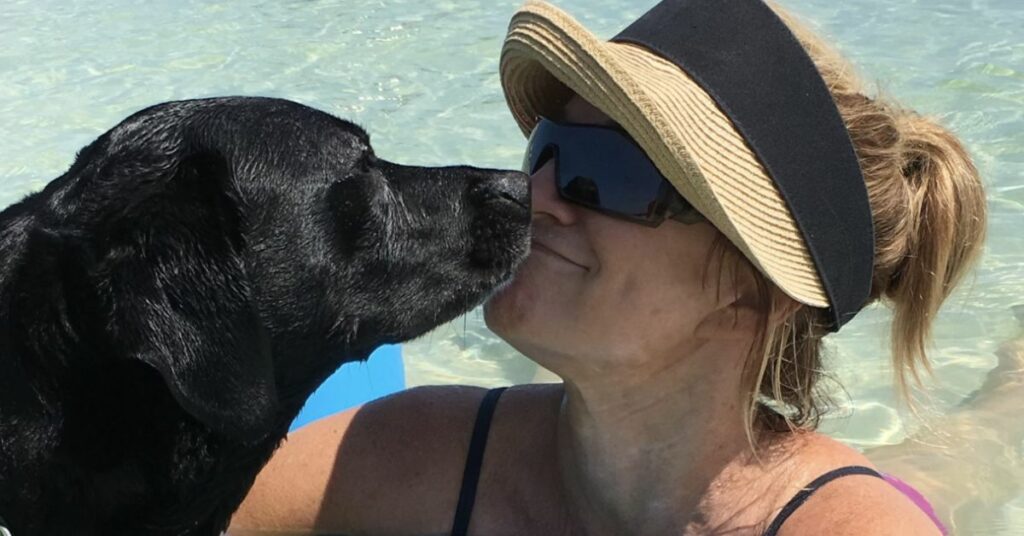

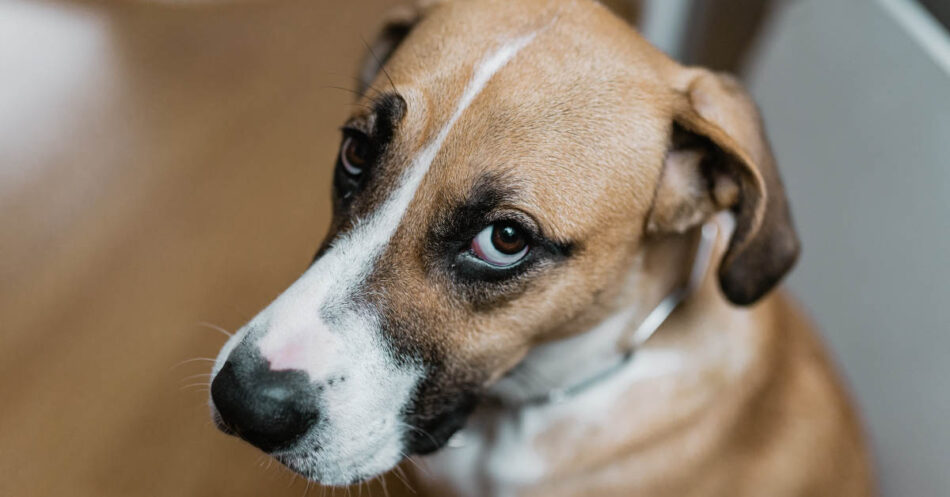
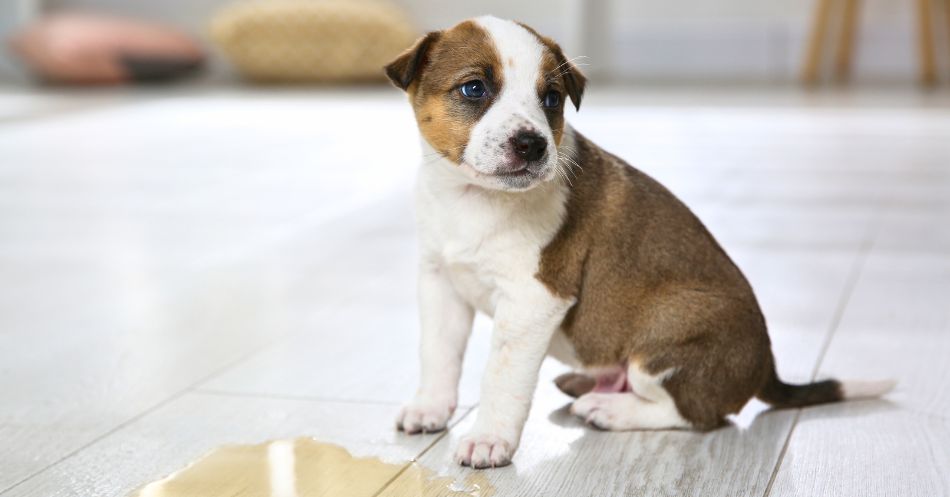
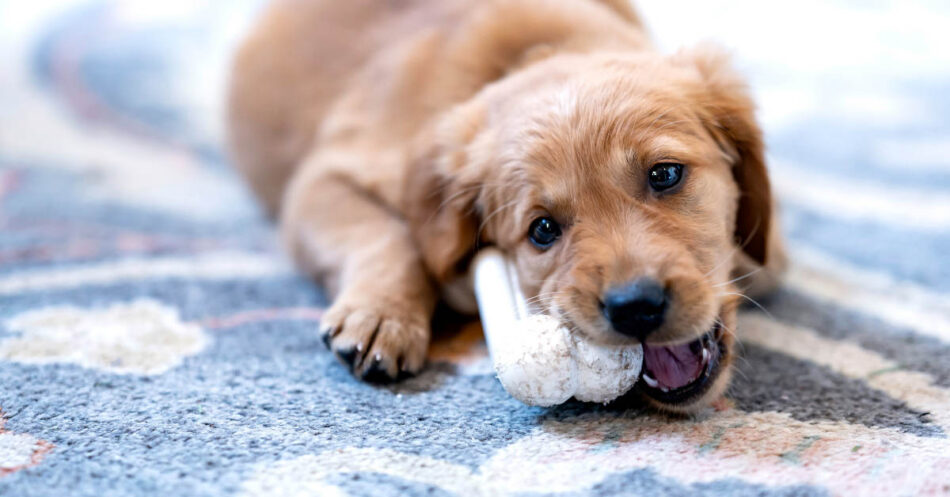
I have two males one hound one pit the hound markes the house an the pit remarks it when we are awake we control the situation but when we go to sleep we put the pit up an he sleeps with my daughter but the hound will go around at night an mark by the couch an entertainment center kitchen an by the door any suggestions on what to do we have all hard wood floors we clean it up very good thanks .
For starters, I would get a strong handheld blacklight. There’s one that actually comes with one of the orange cleaners above if you buy the right package on Amazon (it will show the flashlight on the product photo if it’s the right one).
I had all hard surfaces for my floors too, but some floors will still absorb the urine. When you use that flashlight, you can see all the high places they peed, like corners of couches, tables, chair legs, etc. We even have a folding closet door ours likes to pee on. Chances are that the place up high he actually marked are still there.
You will also see any spots on the floor you might’ve missed that happened to dry before you caught it. As you see when they go outside, even if they have a little dribble left, they will still mark, so those are harder to catch. The problem we had was in unsealed tile grout. You might actually be getting pee between the cracks of any wood or vinyl flooring if it’s had the chance to seep in all night.
Once you’ve thoroughly cleaned everything, I would see about closing the bedroom door to the girl’s room and then practicing crating with both dogs so you can have the other guy sleep there at night and they can sleep there together (if they cuddle) when you’re away. If they keep to themselves I might get two crates. Crates are expensive, especially for larger dogs, so if you can’t buy new I would look for a used one. There are plenty of people that did not properly crate their dog and end up wanting to get rid of their crates.
There are articles and videos for incentivizing your dog to crate and the gist of it is to make the crate inviting and comfortable. So whomever is their “favorite”, I would take a t shirt they’ve worn all day and lay it in there. Then practice putting treats in there so they realize it’s safe to go in. Then let leave the crate open here and there (and take away all dog beds/block access to comfy furniture so they begin going to the crate to get comfortable. Let them hang out in there with the door open when you’re home until you’ve seen them either go to it regularly or even hang out in there for a while.
I felt very hesitant and guilty about crating, but with the peeing during the night, we finally had to do something. It’s also another way to establish yourself as the pack leader. We learned that dogs are den animals, so having a safe space that’s theirs is actually relaxing. The key we found was getting a create with a cover that velcros shut on all sides. So when you go put one to “bed” for the night or go away for a few hours, he won’t see you walking away and feel upset or abandoned.
Even when we’ve gotten up in the middle of the night we expected ours to whine and bark but they must just feel safe enough to relax, because we don’t hear a peep unless we’re coming back from being away for a while. We put the cover on no matter what time of day it is like someone might do over a bird cage. The crate cover is black and not see through, so something like a sheet probably won’t work.
The reason I’m also suggesting to close the door to the kid’s room is to prevent the other dog from hearing the “free” dog waltz in and get a drink right in front of them where he can hear/smell he’s out walking free while he is restricted. In that scenario it’s like putting one dog on a leash and not the other.
A regular potty training tip is one you might’ve done with your daughter, where you didn’t let her drink past a certain time of night. We were letting them drink whenever they wanted and it would just provide my male dog continuous “fuel” when he was done marking one area. We put up our water onto a dedicated space out of reach about three or four hours before we went to bed, and then let them out *right* before bed.
We found even letting them out thirty minutes before putting them to “bed” for the night would cause problems. Like little kids, they might feel the sudden urge right before bed, even if they’ve just gone. Having this routine will also contribute to them feeling comfortable.
And I will warn you about crating that it is super important to *ease* them into crating. I’ve heard of owners seeing this as newfound freedom to be out for a while knowing how long their dog can hold it and expecting to have it do the same. You’ll have to practice coming home shorter periods of time, even with the crate cover on. I don’t want to scare you, but these owners that suddenly crate their dogs while they go away to work all day or hang out for even a few hours without practicing crating can be very dangerous.
With big dogs especially, I’ve heard of them seriously injuring themselves trying to break out of the crate or trying to chew it open. This is clearly a case where they don’t feel safe or are bored and need something to chew to keep them occupied.
I know that was all plenty of information, but just know it’s very important to check out some specific videos or articles for more background and tips on it. I hope you have success with it all, but know that even some progress is still progress! Don’t beat yourself up if you can’t get everything right on your first attempt. Good luck with your pups and breaking this very frustrating habit!
You never want to fully put a cover over the crate. The lack of fresh air is stifling. I once got inside the crate to clean it (we have a bigger one) & did not realize how stifling it was. I felt horrible for covering the crate. Lack of fresh air also can makes it a fearful environment for your dog.
I do agree with crating at night. Get a comfortable bed with cover that can be unzipped to be washed once a month or so. Our dog loves his crate & finds security in it.
I work from home with my three older dogs (spayed pit 6 yo, spayed aussie mix 7 yo, spayed husky mix 11 yo) and they are potty trained. Our friends recently adopted a 1 yo bully mix who is spayed. She is potty trained at her house where she is the only dog. But at our house, she pees. Consistently right outside our bedroom door if we’re dogsitting her. Every single time. We try to catch her but she does it early in the morning when she (and everyone else) has access to the dog door and she knows how to use it as she has one at home. A few days ago my husky mix threw up in my office (she’s fine) and now the bully has peed there. As soon as I turn my back, she takes advantage. She stays over here during the day twice a week to hang out and play with my dogs. We adore her and everyone gets along. But I cannot deal with her constantly marking in my house. What do I do? I’m at my wit’s end. I have trained, fostered, and loved dozens of dogs and never encountered this persistent behavior.
Hello Brianna,
How frustrating! Since she is only marking at your house, it doesn’t sound like there’s a medical reason for her peeing. Anxiety is another common reason for dog marking or peeing. Is she showing any signs of anxiety when she’s around the other dogs?
Another thing that’s super important is cleaning her favorite pee spots thoroughly. If your dog smells even a hint of pee with that super-sensitive nose, they’ll continue to view that location as their bathroom. Enzyme cleaners are the way to go, since they actually break down the waste instead of just masking the scent.
A tactic you might try after cleaning the spot with an enzyme cleaner is to put her food bowl there. Dogs normally do not pee where they eat, so that may discourage her also.
For more tips, you can get my free ebook on stopping your dog’s urine marking.
Hope this helps!
Kristen
We’ve got a 4 year old toilet trained/crate trained dog. He’s started seeing in his crate and night. Not a huge amount, possibly marking. The crate door is open these days and he has the run of a small utility room. We also have an 18mo toddler so wondering if he’s marking because he’s now more mobile and on the move. Washing bedding daily, also on anxiety tabs from the vets, any thoughts? Thank you
Hello,
I’m considering adopting a dog who is at a rescue housed in a vet’s office. The first time I went to visit him, I spent time with him outside. He relieved himself in the yard immediately after leaving his crate. Yesterday, after my application was approved, I went to visit him again. This time he was indoors and wearing a belly band, which completely surprised me. They had told me he was housetrained. He has been marking in the vet’s office, however. The vet’s office smells heavily of dog urine. In fact, I’ve never been in an office that smells so strongly of animals. So part of me thinks it could be the environment. But I also don’t want a dog who marks in the house. Should I just not adopt this dog? Is there such a thing as a little dog who doesn’t mark? Any advice would be appreciated.
Hello Maggie,
That’s so great that you’re looking to adopt a rescue dog! That being said, it’s impossible to know what a rescue dog’s life was like before you found them or how they were trained (or not trained).
There are many different reasons for marking. If the dog isn’t fixed, that can contribute to it. A belly band can also confuse dogs, as it makes them think it is okay to urinate inside the house and doesn’t actually address their behavior. Being in a vet’s office could also lead him to mark to claim his territory with all those other dogs around. He also could be anxious in that environment, which can lead to marking.
Unfortunately, it’s very hard to say how he will behave when he is away from that environment and in your home. If you decide to bring him home, it is important to start training him immediately not to mark. Using the tips in the blog post above – like lowering his anxiety and giving him a lot of exercise – can definitely help.
Hope this helps!
Kristen
Hello I have 2 male malitpoo 1 and 2 year old both are neutered they will be outside and pee once I let them be free in the house I start finding pee on corner of my sofa and my kids toys idk what to do I try putting band on them and the younger one pee in it so now I have them both in crates what can I do .? I don’t want them crates I feel bad
Hello Jelissa,
Pee problems can be so frustrating! If you keep finding pee in the same places, thoroughly cleaning it with an enzymatic cleaner should be the first step. These cleaners break down the waste and eliminate it completely. Otherwise, your dog’s sensitive nose can detect traces of urine that we can’t. And if they smell urine, they will think that spot is their potty! Once you’re positive the area is completely pee-free, it’s time to move on to the behavior.
There are a lot of different reasons why dogs mark or pee in the house. This post on why dogs pee in the house can point you in the right direction. I saw you mentioned using belly bands. Sadly, while they are a tempting solution, those can sometimes make pee problems worse in the long run. This post about dog belly bands will give you more details.
I hope this helps – I wish you and your pups all the best!
Kristen
Thank you for the helpful tips! We’ve been struggling with our dog’s marking behavior, and I appreciate the practical steps you provided. Looking forward to trying the crate training method and exploring those scent neutralizers. Fingers crossed it works!